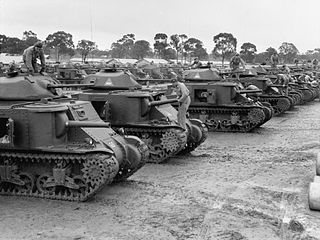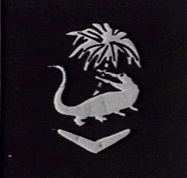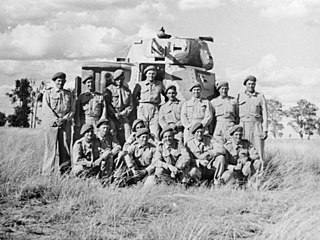
The 1st Armoured Division was an armoured formation of the Australian Army, raised in 1941 as part of the Second Australian Imperial Force (AIF) during World War II. While the Division was originally to be deployed to North Africa in late 1941, it was retained in Australia following the outbreak of the Pacific War. The 1st Armoured Division formed a key element of Australia's defences against a feared Japanese invasion and was disbanded in Western Australia in September 1943.

The 9th Division was a division of the Australian Army that served during World War II. It was the fourth division raised for the Second Australian Imperial Force. The distinctions of the division include it being:

The Battle of Tarakan was the first stage in the Borneo campaign of 1945. It began with an amphibious landing by Allied forces on 1 May, code-named Operation Oboe One; the Allied ground forces were drawn mainly from the Australian 26th Brigade, but included a small element of Netherlands East Indies personnel. The main objective of the landing was capture of the island's airfield. While the battle ended with success for the Allied forces over the Japanese defenders, this victory is generally regarded as having not justified its costs. The airfield was so heavily damaged that it ultimately could not be repaired in time to make it operational for other phases of the Allied campaign in Borneo.

The 4th Armoured Brigade was an armoured formation of the Australian Army established during the Second World War. It was formed in February 1943 to provide armoured support for infantry units operating in the South West Pacific Area. Its composition varied over time, but usually comprised several armoured regiments equipped with Matilda II or M3 Grant tanks as well as some support units.

The 2nd Armoured Division was an armoured formation of the Australian Army during World War II. Originally raised in 1921 as the 2nd Cavalry Division, based in Victoria and South Australia, the formation had been converted into a motor division in early 1942, before adopting the armoured designation later in the year. A Militia formation, the division undertook garrison duties in Australia and did not see combat before being disbanded in mid-1943.

Armoured units made a relatively small, but important, contribution to Australia’s war effort during World War II. While Australia formed three armoured divisions and two independent armoured brigades during the war, Australian armoured units only saw action as independent regiments and companies supporting larger infantry formations. Early actions were fought in the Middle East by the divisional carrier regiments that supported the 6th, 7th and 9th Divisions, fighting in Libya, Egypt and Syria in 1941–42, before the Australian divisions returned to Australia in 1942–43. During the early fighting in the Pacific, there was a limited role for armoured formations, although one armoured regiment – the 2/6th – took part in the fighting around Buna–Gona in late 1942. Later in the war, though, during the Huon Peninsula, Bougainville and Borneo campaigns of 1943–45, several armoured units were used by Australian forces in the infantry support role.

The 2/6th Cavalry Commando Regiment was a cavalry regiment of the Australian Army that served during the Second World War and was later converted into a commando unit. Formed at Ingleburn, New South Wales, in November 1939, it was originally raised as an armoured reconnaissance regiment attached to the 6th Division. In that role, the 2/6th saw action in the North Africa campaign and in the Middle East during 1940–41, where the regiment distinguished itself at Bardia, Tobruk and in Syria. Later, following Japan's entry into the war, the 6th Division was brought back to Australia and following a re-organisation, the regiment was converted into a cavalry commando regiment, incorporating the independent companies that had been formed at the start of the war. In late 1944, the 2/6th Cavalry Commando Regiment was deployed to New Guinea, where it participated in one of the final Australian campaigns of the war in the Aitape–Wewak area.

The Battle of Labuan was an engagement fought between Allied and Imperial Japanese forces on the island of Labuan off Borneo during June 1945. It formed part of the Australian invasion of North Borneo, and was initiated by the Allied forces as part of a plan to capture the Brunei Bay area and develop it into a base to support future offensives.

The Royal Wiltshire Yeomanry (RWY) was a Yeomanry regiment of the Kingdom of Great Britain and the United Kingdom established in 1794. It was disbanded as an independent Territorial Army unit in 1967, a time when the strength of the Territorial Army was greatly reduced. The regiment lives on in B and Y Squadrons of the Royal Wessex Yeomanry.
The 2/4th Commando Squadron was one of 12 independent companies and commando squadrons raised by the Australian Army during the Second World War. Raised in August 1941, it was disbanded not long after due to conceptual problems, but it was quickly reformed following the entry of Japan into the war in December 1941. After a period of about six months performing garrison duties in northern Australia, the 2/4th was deployed to Portuguese Timor to reinforce the other Australian units already waging a guerilla war on the island. After a brief campaign the 2/4th was returned to Australia and from there it went on to serve in New Guinea in 1943, taking part in the Salamaua-Lae campaign attached to the 9th Division. Later, the squadron was involved in one of the last campaigns of the war when it landed on Tarakan Island in May 1945 and took part in the Borneo campaign. Following the end of hostilities, the 2/4th returned to Australia and was disbanded at Ingleburn, New South Wales, on 8 January 1946.

The 2/9th Armoured Regiment was an armoured regiment of the Australian Army. Raised for service during World War II, the regiment was formed in August 1941 and spent most of the war in Australia. It was disbanded in early 1946 after seeing action in the Borneo campaign late in the war.

The 2/6th Commando Squadron was one of 12 independent companies or commando squadrons raised by the Australian Army during the Second World War. Raised in May 1942 as the 2/6th Independent Company, the 2/6th's main role was to conduct irregular type warfare including small scale raiding, sabotage, long-range patrolling and reconnaissance operations rather than the traditional commando type direct action operations. As such, for the most part the unit conducted operations in small groups operating inside enemy territory, or out in front of larger friendly forces. Between 1942 and 1945, the 2/6th undertook four major campaigns during the war—Kokoda, Buna, Markham–Ramu and Borneo—and was involved in arguably one of the most spectacular small unit actions of the war during the Battle of Kaiapit. The unit was disbanded in January 1946, following the cessation of hostilities in the Pacific.
The 2/7th Cavalry (Commando) Regiment was one of three commando regiments raised by the Australian Army for service during World War II. It was originally raised as the 7th Division Cavalry Regiment in 1940 and in this guise it served in North Africa and the Middle East at the beginning of the war, before it was brought back to Australia and sent to New Guinea in late 1942 to serve against the Japanese. In mid-1943 the Australian high command decided to disband the divisional cavalry regiments and use their headquarters elements to administer the independent companies that had been raised earlier in the war. In the process the 7th Division Cavalry Regiment disbanded its squadrons, gave up their vehicles and changed its name to the 2/7th Cavalry (Commando) Regiment, as it became the administrative headquarters for the 2/3rd, 2/5th and 2/6th Commando Squadrons.

The 2/11th Commando Squadron was a commando unit raised by the Australian Army for service in World War II. Raised in 1944, the unit saw action late in the war against the Japanese during the Borneo campaign in 1945. As a part of this campaign the squadron undertook landings on Labuan Island and at Brunei Bay. Following the end of the war, the squadron returned to Australia and was disbanded in early 1946.

The 2/12th Commando Squadron was a commando unit raised by the Australian Army for service in World War II. Raised in 1944 following a re-organisation of Australia's military forces, the unit participated in the Borneo campaign in 1945 but played only a limited role before hostilities ended. Following the end of the war, the squadron returned to Australia and was disbanded in early 1946.

The 1st Armoured Brigade was a formation of the Australian Army during World War II. The brigade was formed in July 1941, at Greta, New South Wales from volunteers for the Second Australian Imperial Force and was assigned to the 1st Armoured Division. Raised initially for service in the Middle East, following Japan's entry into the war, the brigade was assigned to the defence of Australia in case of an invasion. After garrison duties in New South Wales and Western Australia, it was disbanded in November 1944 without seeing active service, although some of its former units saw action later with other formations.

The 2nd Armoured Brigade was a formation of the Australian Army during World War II. The brigade was formed in July 1941, at Puckapunyal, Victoria, from Second Australian Imperial Force volunteers. It was assigned to the 1st Armoured Division in July 1941, with the intention of deploying it to the Middle East. However, it was reassigned to home defence following Japan's entry into the war, and was then transferred to the 3rd Armoured Division in October 1942. The brigade remained in Australia, undertaking defensive duties in Victoria and Queensland before being disbanded in January 1944. While it did not see any active service as a formation, some of its constituent units eventually took part in the campaigns on Tarakan, Labuan, Bougainville and around Aitape–Wewak in 1944–1945 after transferring to other brigades.

The 3rd/9th Light Horse is a Reserve light cavalry regiment of the Australian Army based in Smithfield, South Australia. Part of the Royal Australian Armoured Corps (RAAC), the regiment is attached to the 9th Brigade, 2nd Division and currently operates G-Wagon SRV 6x6 and Bushmaster Protected Mobility Vehicles.

The Australian Army has used tanks from after the First World War, through the interwar period, the Second World War, the Cold War and to the present day. Throughout this period the Army has primarily been a light infantry force, with its tanks mainly being used in the direct support role. The Australian Army's tanks have seen combat during the Second World War and the Vietnam War, where they proved successful despite some of the designs employed being considered obsolete. The first Australian tanks were a small number of British medium and light tanks which were operated mainly for training purposes during the 1920s and 1930s.

The 2/3rd Anti-Tank Regiment was an Australian Army anti-tank artillery regiment that was raised for service during the Second World War as part of the all volunteer Second Australian Imperial Force. It was formed in July 1940, and was assigned to the 8th Division, but was later reassigned to the 9th Division. With this formation, the regiment took part in the Siege of Tobruk in 1941 and then the First and Second Battles of El Alamein in 1942. After returning to Australia in early 1943, the regiment became a corps-assigned unit, and its individual batteries served in New Guinea in 1943–1944, and then Borneo against the Japanese in 1945.



















